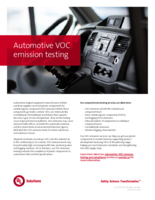
Automotive VOC Emission Testing
Automotive suppliers need to validate the compliance of their components to certain OEM specifications for emission behavior prior to their use in the vehicle interior.

All plastic materials (thermoplastics, elastomers, thermosets and composites) can release volatile organic compounds (VOCs) into the ambient air. Depending on their concentration, these VOCs have an influence on the odor perception, well-being or health of people inside the vehicle.
As a result the automotive industry has issued regulations for certain substances and substance classes in the field of vehicle indoor air quality (VIAQ).
The emission behavior is typically analyzed by the following test methods:
In the automotive industry two different methods are used for determining VOC emissions by the means of thermal desorption.
On the one hand, it is possible to carry out the determination at the material level according to VDA 278. Small amounts of material are placed directly in the thermodesorption tube, heated in the thermodesorber using a controlled temperature program and the volatile (VOC) and semi-volatile (FOG) organic compounds released are analyzed using GC/MS.
On the other hand, the VDA 276 can be used for VOC analysis at the component level. The component is stored in a 1 m3 emission chamber at a defined temperature and time. The organic compounds released are collected on Tenax-filled thermodesorption tubes and analyzed using the thermodesorption GC/MS.
In addition to VOC analysis using TD-GC/MS, the VDA 276 can also be used to determine other substance classes (carbonyls, amines, nitrosamines) applying other analytical methods (e.g. HPLC).
Common standards for VOC
VDA 278, ISO 12219-4, ISO 12219-6, VDA 276, PV 3942, GS 97014-3, VW 96043, (PN780), or equivalent standards
The Headspace GC/FID method according to VDA 277 enables the determination of the total carbon content of plastic materials.
With a slight modification, the Headspace GC/MS analysis serves as an extension to determine the main individual emitted substances.
Common standards for headspace
VDA 277, PV 3341, or equivalent standards
Organic compounds released from interior components can also be perceived as specific odors. The VDA 270 is suitable for testing the odor perception of the individual parts of a component as well as the entire component.
The sample is conditioned with a defined volume in a vessel on the basis of certain specifications (sample quantity, temperature and humidity). The air in the vessel is evaluated by three trained odor testers with an evaluation scale from 1 (not perceptible) to 6 (not acceptable).
In addition to the evaluation from VDA 270, other OEM-specific evaluation schemes can be used to describe the odor in more detail.
Common standards for odor testing
VDA 270, PV 3900, ISO 12219-7, GS 97014-4, or equivalent standards
VDA 275 determines the formaldehyde content by using the flask method.
The release of formaldehyde from plastic components of the vehicle interior can not only lead to an unpleasant odor but also to impairment of health, which is why special attention is paid to this substance. As formaldehyde is a very volatile substance which cannot be determined with either VDA 278 or VDA 277, the special flask method is utilized.
Common standards for formaldehyde
VDA 275, PV 3925, or equivalent standards
Besides volatile organic compounds (VOC), plastics and other non-metallic materials release semi-volatile organic compounds (FOG).
Such compounds can condense on colder surfaces (e.g. windshields) and lead to a layer that impairs visibility. This effect is also known as window fogging.
As part of the Production Part Approval Process (PPAP), this behavior of materials used in the interior of car cabin can be analyzed and quantified by utilizing the respectively designed fogging test method.
Common standards for fogging
DIN 75201, PV 3015, or equivalent standards
Thanks for your interest in our products and services. Let's collect some information so we can connect you with the right person.